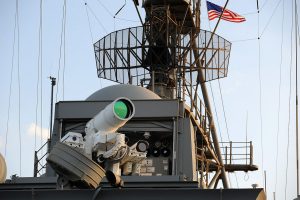Over the past 5-10 years there’s been a lot of research and development into new weapons systems that can only be described as space age. These weapons include powerful lasers and projectiles launched by huge electromagnetic (EM) fields. If you think these weapons seem like something straight out of Star Trek or Star Wars you’re not alone.
For the past fifty years or so the state of the art in naval weaponry has been the guided missile. Whether launched from a ship or fired from a plane the increased range and deadly accuracy of a modern missile has almost made the old time naval gun a relic of history. Ships no longer fire their cannon in broadsides and planes no longer dogfight with machine guns, in today’s battle its launch a ‘fire and forget’ missile.
While missiles clearly have distinct advantages, they also certainly have disadvantages. One of these is the fact that being so much larger than shells or bullets a ship or plane can carry far fewer of them. Even more of a disadvantage is the far greater cost of a missile versus a shell or bullet.
The new technologies under development are intended to remedy those problems with systems whose launchers may be large and expensive but the projectiles they fire are much smaller and far cheaper than a guided missile.
The first system we’ll discuss is a ‘Laser Weapon System’ or LaWS in military speak. Now militaries have been trying to weaponize lasers almost since the laser was invented but have never quite managed to make them ‘battle ready’. In the 1980s the United States Navy (USN) tried very hard to develop an anti-aircraft system using chemical lasers but the system was never quite powerful enough to shoot down aircraft and the chemicals in the lasers made them almost as deadly to the seamen firing them as to their targets.
Modern solid-state lasers have changed that. In fact the Navy’s latest version of it’s LaWS system consists of an array of six high power solid state lasers that can deliver a total of 33kW of power. This prototype was fitted unto the U.S.S. Ponce (a amphibious transport type ship) for testing under operational conditions and deployed to the Persian Gulf in 2014.
During the past two years of testing LaWS has successfully destroyed airborne drones, detonated a rocket propelled grenade while in flight and disabled the motor of a rigid-hulled inflatable boat. One special ability of LaWS is that the system can reduce its output power, even down to the point of just dazzling the eyes of attackers without doing any permanent damage. Best of all, the ‘bullets’ for LaWS are literally limitless and cost less than a dollar per shot!
The system has performed so well that the Navy has declared it to be an operational asset allowing the captain of the Ponce to actually use it in combat at his discretion. An upgraded LaWS system, with a maximum power of 60-100kW that would allow it to shoot down helicopters and some aircraft is being readied. Over the next several years this new system will begin to be deployed on the Navy’s destroyers and Littoral Combat Ships. The picture below shows the current LaWS as mounted on the U.S.S. Ponce.

The second, and even more powerful weapons system being developed by the Navy is the electromagnet railgun. This weapon uses a short but tremendously powerful magnetic pulse to accelerate a metal projectile to seven times the speed of sound (Mach 7 as its know), or about 2.5km per second, and hurl it over 160km.
Now undergoing testing at the Navy’s Dahlgren Surface Warfare Center the Navy’s prototype railgun uses 32MJ (that’s 32 million Joules of energy) in the form of over a million amps of electrical current to fire its 3.2kg projectile. As with LaWS, the small size of the projectile, and the fact that only electricity is needed to fire it, are enormous advantages for the railgun. The link below will take you to some Youtube videos of the railgun firing.
https://www.youtube.com/watch?v=D2sRVORr2ks
This version of the railgun is now ready to undergo shipboard testing, probably on the USS Millinocket one of the Navy’s Expeditionary Fast Transport ships. Deployment of a 64MJ railgun onto the new Zumwalt class destroyers is planned to begin around 2020.
There are still problems are be solved before the railgun is completely battle ready however. The biggest problem is without doubt the tremendous wear and tear on the rails that the projectile slides down. Although the details are secret it appears that the Navy has managed to make considerable progress on solving this problem. They have informed congress of a successful firing of 400 shots with a single set of rails and expect to increase that to 1000 shots.
Another problem is guidance for the projectile. Any system to guide the projectile during flight will first have to survive the great heat, high magnetic field and gargantuan forces generated when it’s fired.
Still, I can remember when I made my first little coilgun (a relative of the railgun) in my basement and wondered if anybody would ever make a successful EM weapon.
